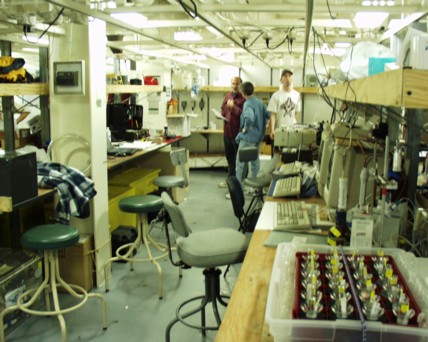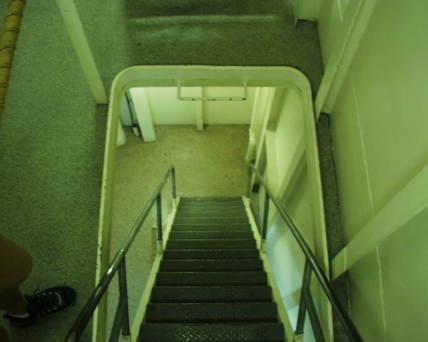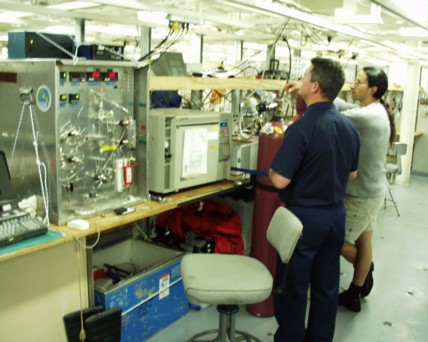|
|
Expedition
Expedition | People
|
Log - July-22-2003
by Gerhard Behrens and Robert McCarthy
Previous | Next
| Steaming north |
| This is our second day of "steaming" north. The scientists are using this time to test their equipment and to make a schedule of when experiments will happen. This important and difficult science work can only happen with an excellent ship and a terrific crew. Keep reading to find out about this amazing ship.
|
 |
It is 420 feet long, that's about one and a half soccer fields long.
The ship weighs 16,000 long tons. That means the ship needs about 36 million pounds of water so it will float. That's 4,500,000 gallon jugs of water.
There is 4,200 square feet of lab space, that's about the size of 2 houses. This lab space is ready for holding special ocean testing equipment, mixing chemicals, collecting water samples, keeping track of weather, developing pictures, and gathering information in a computer lab. Check out the pictures of some of our lab space.
The ship can break ice that is 8 feet thick.
Everything will still work if the outside temperature is -50 F, that's 82 degrees below freezing.
The ship has five cranes and lots of winches for lifting and moving heavy things.
The kitchen bought $210,000 worth of groceries for this trip. (More on the wonderful kitchen another day!)
About 130 scientists and crew can live on the ship.
A "Plan of the Day" is put up each day that gives the times for meals and meetings.
There is an exercise room with 3 sets of weights, 3 exercise bikes, 2 stair stepping machines, 2 treadmills, and 2 rowing machines.
There are two plastic owls taped to the front (bow) of the ship. They are meant to scare away other birds that want to land on the ship and leave a mess! The crew just used duct tape to keep them fastened, and they're as solid as a rock.
There are three "living rooms" to watch movies or just relax, and a library
full of books.
The ship is a home away from home, and a lab away from home, for us all.
Find out more about the USCG Healy at
|
|
First the answers from yesterday's questions: The circumference of the earth based on the numbers given to you is 40,003 km. 17 nm/hr is equivalent to 19.6 miles per hour, and assuming 17nm/hr, we will have traveled 756 km in 1 full day, which is about 6.8 degrees of latitude.
|
 |
Today we were awakened to the sound of fog horns. Traveling north, we experienced warmer air over cold ocean temperatures which creates condensation of the moist air, termed fog. California is a good example, as the cold waters in San Francisco Bay interacts with the warm air above to create fog under the Golden Gate Bridge. The ship blew the fog horns every four minutes to warn potential ships of our approach. I started hearing them around 0400 hours, and this continued until the fog lifted by around 0700 hours. I never heard another distant reply, but the shipÕs radar was watched keenly. I heard there was an ice-berg sighting this morning to our west, and the predominant flow south out of the Baffin Bay is along the east coast of Canada. |
 |
Today is fairly calm, although the winds and sea state have increased so the ship's motion is more easily detectable. I'm starting to establish a routine of life onboard the Healy. The research is still 2 days away so scientists are checking the equipment and trouble shooting as best they can. But the relaxed atmosphere will certainly change once we arrive on station. Daily diversions include working out in the gym, (freeweights, weight machines, treadmills, steppers, exercise cycles, and rowing machines), taking pictures with my 35 mm camera as well as a digital one for the web, logging activities for the journal, and talking to scientists about their research. Also the crew shows movies in the evenings, and they have a nice library on the ship with a diverse collection of books. |
|
Today's calculation involves the fuel capability of the Healy. Total capacity is listed at 1,220,915 gallons (4,621,000 liters). If the density of the fuel is 880 kg per meter cubed, how much water (in liters) is displaced when the tank is full? What is the mass of this water? Given that 1 meter cubed is 1000 liters, and the density of seawater is 1023 kg per meter cubed.
|
|
